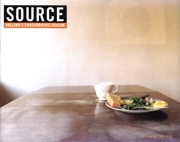Chambers
'Chambers', photographs by Mary McIntyre - Old Museum Arts Centre December 1998
Review by Eoghan McTigue
Issue 17 Winter 1998
View Contents ▸
Mary McIntyre has made some distinct decisions installing 'Chambers' at the Old Museum Arts Centre, the installation consists of two light boxes, one large, one small, each depicting an aspect of the interior of a local council chambers. McIntyre has set a false wall 3 feet into the space and 7 feet wide blocking our view of the main image and deliberately restricting our approach to the work. As an extension of the curtains, a central motif in the photographs, the entire gallery space has been painted a deep navy blue.
The main photograph is a 6' x 4' symmetrical image of a council chambers meeting room. The council chambers represents local power structures in Northern Ireland, and even though we're dealing with mundane cul-de-sac politics, authority is clearly invested in this space. The installation of the work asks that we confront this image both physically and psychologically and consider the nature of this assembly, and what our relation to it could be? 'Chambers' is what authority looks like. However the word 'authority' is not as oppressive as it first may seem; it has its roots in the Latin 'auctoritas' which also means 'protector' and this ambiguity places us in a more ambivalent relationship with the image.
A heavily lacquered, honey coloured, oval table flanked by six rich leather-backed chairs cuts into and spans the lower half of the frame of the main image. Every surface in these images aspires to be rich and austere. The carpet is densely textured and patterned, the navy velvet curtain drops to the floor and obscures our view beyond the immediate assembly, the door of the room is studded and the ashtrays on the table are so baroque they could double up as inkwells. This is a scary world. At the same time both images contain details that deliberately disrupt this austerity, the arm of a Chubb fire extinguisher and the little blue and white Health and Safety sticker unsettlingly remind us of the contemporaneity of these spaces. The image is typically depopulated, and as with other work it is devoid of any specific reference. It hangs there ambiguously, its function suspended, as the scene of an event just passed or just about to happen.
The drawn velvet curtain in this image tilts the table and chairs forward a little more oppressively into our viewing plane, the false wall behind our backs props us uncomfortably close to the image, unable to back away we are forced to confront it. The image and its proximity presents a set of demands. Does it protect or threaten us or, does it involve us more directly? There's a chilling turning point in the toilet scene in 'The Shining', a film that also uses claustrophobia to good psychological effect, when Jack Nicholson realizes he is not just a passive spectator of all the mysterious apparitions at the Overview Hotel, but he is their central character. He 'is the caretaker'. Similarly this photograph could passively be perceived as an objective image of an assembly that has nothing to do with us, or, more chillingly this could be a mirror image, a portrait of us, a metaphor for our own relationships and hierarchies in society played out in this staged and claustrophobic installation.
The second light box, installed on the back wall of the gallery space, depicts the doorway of the same chamber room. Symbolically offering us a 'way out' of this closed psychological environment, this may seem to some like an adjunct to the rigorous demands established between the viewer and the main image.
Either way the installation succeeds in dramatising an open and ambiguous relationship between the viewer and this image. As we meet this image in the space specifically constructed for it we become aware that authority, like fear, is always a double sided coin, we're not only subject to its effects but we subscribe to and play our part in its construction.
Other articles mentioning Eoghan McTigue:
Other articles mentioning Mary McIntyre:
Other articles on photography from the 'Institutional' category ▸






